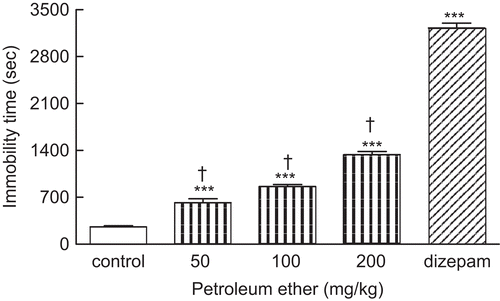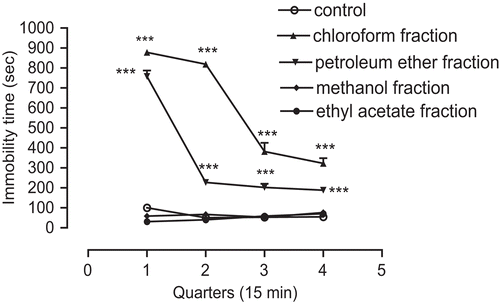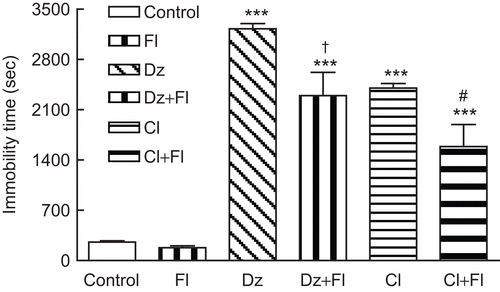Figures & data
Figure 1. Effect of the chloroform fraction of A. annua extract (50, 100, and 200 mg/kg, i.p.) on duration of immobility. Administration of chloroform fraction increased immobility time as sedative effect in a dose-dependent manner. Treatment of animals with diazepam (3 mg/kg, i.p.) as positive control induced sedation significantly (***P < 0.001). Data are presented as mean ± SEM of seven mice. ***P < 0.001 shows significant difference with control group. †P < 0.001 compared the statistical difference with diazepam-treated mice (positive control).

Figure 2. Effect of the petroleum fraction of A. annua extract (50, 100, and 200 mg/kg, i.p.) on duration of immobility. Administration of petroleum fraction increased immobility time as sedative effect. Treatment of animals with diazepam (3 mg/kg, i.p.) as positive control induced sedation significantly (***P < 0.001). Data are presented as mean ± SEM of seven mice. ***P < 0.001 shows significant difference with control group. †P < 0.001 compared the statistical difference with diazepam-treated mice (positive control).

Figure 3. Time course effects of chloroform, petroleum ether, methanol, and ethyl acetate fractions of A. annua extract on immobility duration in mice. Immobility time was recorded as sedation during four quarters (15 min). The maximum response was obtained in first quarter and with chloroform fraction. Data are presented as mean ± SEM of seven mice. ***P < 0.001 shows significant difference with respective control group.

Figure 4. Effect of flumazenil (3 mg/kg, i.p.) on chloroform fraction-induced immobility. Pretreatment of animals with flumazenil (3 mg/kg, 15 min, i.p.) caused significant (#P < 0.05) reduction in immobility time induced by chloroform fraction (200 mg/kg, i.p.). Administration of flumazenil (3 mg/kg, i.p.) also decreased sedation induced by diazepam (3 mg/kg, i.p.) significantly (†P < 0.01). Data are presented as mean ± SEM of seven animals in each group. The abbreviations used are as follows: Dz: diazepam, Cl: chloroform fraction, Fl: flumazenil. ***P < 0.001 shows significant difference with control group. †P < 0.01 compared the statistical difference with diazepam-treated mice (positive control). #P < 0.05 indicates the difference with chloroform fraction.
